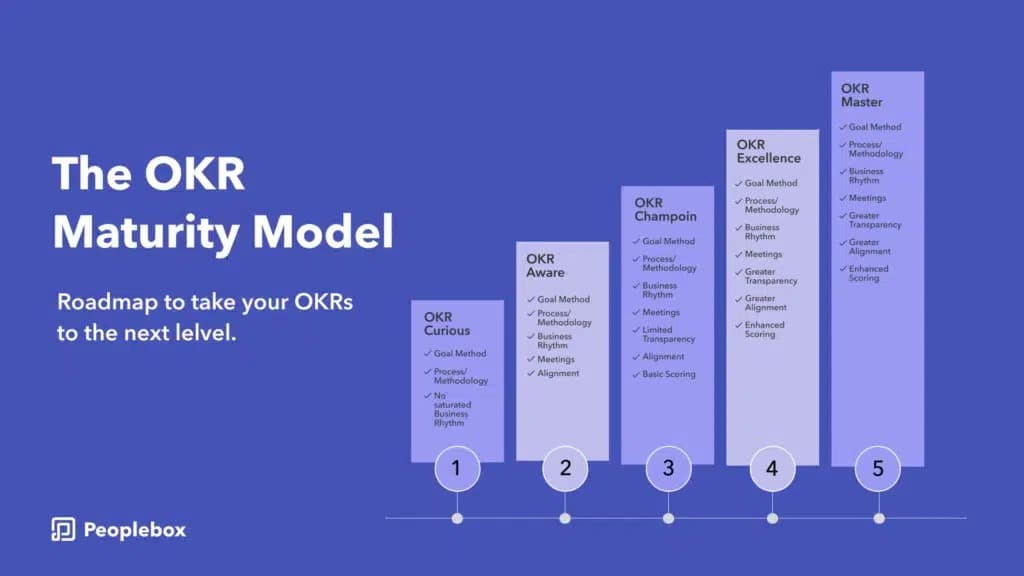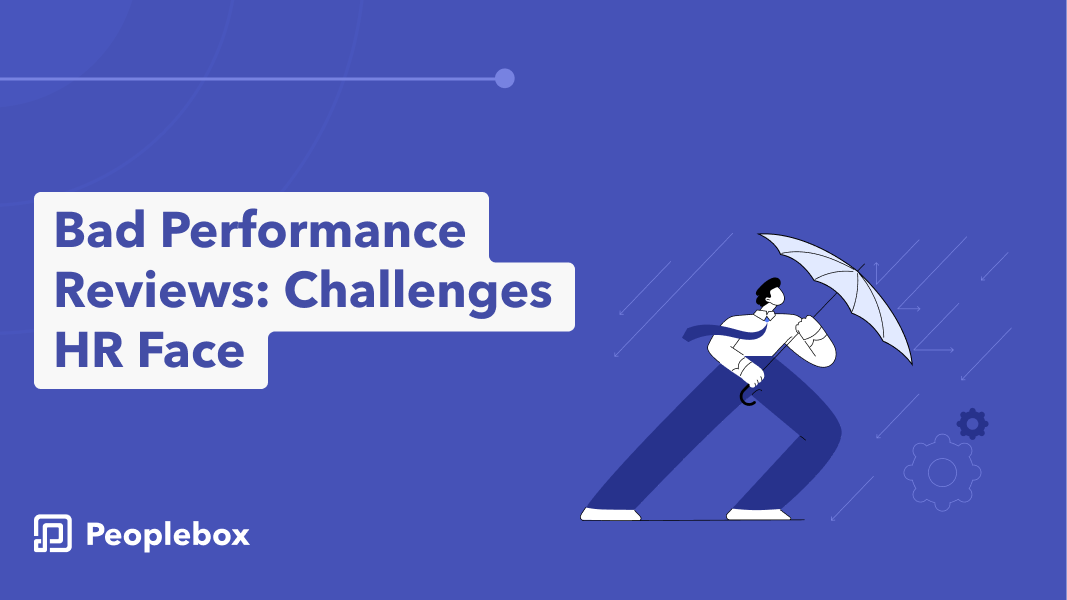OKRs continue to be a popular topic, especially in the current era of remote work. Organizations are searching for the most effective way to use OKRs to improve employee performance and successfully execute their strategies.
Adopting the objective and key results (OKR) methodology can lead to better alignment within your business, faster growth, increased employee engagement, and increased transparency. In fact, those who set actionable tasks for their goals and create weekly progress reporting to their support peers tend to achieve 40% more than those who don’t.
In this article, we propose a model for assessing the capability and readiness of your organization’s OKR approach.
While there are already several OKR Maturity models available, many of them are limited by the capabilities of the author’s software or consulting offerings. Our model, developed based on research and extensive organizational experience, may serve as a more comprehensive starting point for your organization.
However, before jumping on to the model, let’s discuss some basics.
What is an OKR Maturity Model?
The OKR (Objectives and Key Results) maturity model is a framework that helps organizations assess and improve their adoption and effectiveness of the OKR method of setting goals and measuring progress.
Once an organization defines its mission, vision, and values, it must start implementing OKRs. When adjusting their approach to goal setting and achievement, it is important to take a comprehensive approach.
This should involve building a strong foundation that can be refined and improved over time. Neglecting to follow these principles of gradual progress often leads to failure. Instead of rushing ahead, it is important to take the time to establish a solid foundation.
The foundation will help the entire organization to work towards achieving the same goal in a given timeframe.
Goal Setting Maturity Model: The 5 Stages
Here are the 5 stages of the OKR maturity model. Every maturity model is different, but this is what most of them look like.

Stage 1: Curiosity
In this stage, the company or team currently has a task management or goal-setting system in place but is unfamiliar with the OKR framework and has yet to experience implementing it. There is no formal or organized process or methodology in place.
The idea here is to define the goals at a broader lever and mention the timeframe under which you plan to achieve them. Here you may or may not start tracking the progress.
Stage 2: Awareness
In this stage, the organization has a basic understanding of OKRs and is starting to set and track goals. However, the process is still somewhat disorganized and may not be consistently followed by all team members.
To continue moving forward, define the goals individually and let everyone know their roles and responsibilities in this stage.
Stage 3: Champion
At the champion level, OKRs are aligned with the company’s overall strategy and vision, and all employees are involved in setting and tracking their own OKRs. The organization has a clear and consistent process for OKR goal setting, review, and feedback, and there is strong support and buy-in from leadership and management.
At this level, the organization has also established key performance indicators (KPIs) to track progress and measure success, and there is a culture of continuous learning and improvement. The organization can adapt quickly to change and stay ahead of the competition due to its agile and responsive OKR approach.
What to do: Keep up the momentum and continue iterating the process per the requirements.
Stage 4: Excellence
The OKR Maturity Model Excellence stage is the highest level of achievement in the OKR process. At this stage, an organization has fully integrated the OKR methodology into its culture and operations and has consistently achieved its objectives and key results.
At the Excellence stage, the organization has:
- Clearly defined and communicated OKRs at all levels of the organization
- A strong system in place for regularly reviewing and updating OKRs
- A culture of transparency and open communication around OKR progress and results
- A focus on continuous improvement and learning from past OKR results
- A high level of employee engagement and buy-in to the OKR process
- Strong leadership support and commitment to the OKR process.
At the Excellence stage, the organization is able to achieve its goals consistently and drive meaningful progress and innovation, thanks to the clarity, focus, and alignment provided by the OKR process.
Stage 5: Master
The OKR maturity model master stage is the highest level of OKR implementation within an organization. At this stage, the organization has fully embraced and integrated OKRs into all aspects of its operations, including decision-making, goal-setting, and performance evaluation.
At the master stage, the organization clearly understands how to align its OKRs with its overall strategic direction. It has established a culture of continuous improvement and accountability. It has also developed a robust system for tracking and measuring progress towards its OKRs, including regular check-ins and reviews to ensure that all stakeholders are aligned and working towards common goals.
In addition, the organization has a strong leadership team committed to driving OKR adoption and implementation and has invested in the necessary resources and training to ensure that all employees can contribute to the organization’s OKRs.
Overall, the OKR maturity model master stage represents a fully-integrated and highly-effective approach to goal-setting and performance management that drives success and continuous improvement within the organization.
OKR Software - Rated 4.8 on G2
Empower your managers to be a better leader with essential performance tools & personalized coaching support.
How an Organization can Achieve Success With OKR Maturity Model
Knowing about the stages of the maturity model isn’t enough. You need to implement it in the right way to achieve success. Here are a few tips to help you succeed with the OKR maturity model.
Build a Strategy that Everyone Understands
In order to achieve truly impressive results, it is important to communicate your strategy clearly and effectively to your team. This means breaking down the long-term strategy into specific, achievable objectives for the current year, quarter, and month.
These objectives should be easy for your team to understand and relate to and should be defined using a structured goal management framework with specific, measurable, achievable, relevant, and time-bound (S.M.A.R.T.) metrics.
Additionally, it is important to ensure that these objectives are comprehensive and thorough, covering all relevant focus areas and leaving no blind spots.
Define the Strategy
To align the organization through OKRs, you must determine the necessary tasks, assign them to specific individuals, and establish deadlines. By linking work units to the organization’s strategy through shared objectives and key results, the organization can create a cohesive and effective approach to achieving its goals.
To ensure success, you should also examine if there is a strong integration of goals vertically and horizontally, a clear connection between goals and their supporting tasks, evidence of cross-functional collaboration, and visibility and alignment of OKRs throughout the organization.
Focus
To achieve success as an organization, it is essential to concentrate on the fundamental tasks that contribute to success and eliminate those that take up a lot of time and effort with little benefit.
It is important for everyone to understand their role in the organization and how it impacts the overall goals and results, contributes to the success of the strategy, and aligns with the organization’s larger purpose.
Frequent Cadence
The traditional rhythm of business, which was previously based on an annual schedule, has been disrupted by the past year’s events. Even a quarterly schedule may not be sufficient to keep up with the rapid changes occurring within businesses.
One solution to this problem is using OKRs (Objectives and Key Results), which allow for a continuous process of strategizing and aligning goals. In order to be successful, organizations must have ongoing performance reporting and regular conversations about performance in order to learn and adapt their objectives and key results.
Agile organizations are able to maintain alignment through the use of OKRs.
When examining the effectiveness of OKRs, we should consider whether the organization is constantly testing hypotheses and evolving goals, whether there is a smooth process for refreshing objectives, and whether there are technologies in place that facilitate transparency and ease of use.
Powerful Leadership
Leadership drives an organization’s performance, which OKRs power. Effective leadership behaviors, such as meetings, decision-making aligned with OKRs, timely support, and agility, contribute to improved performance.
OKRs also provide a framework for leaders to ensure everyone is working towards the same goals and to receive feedback on their actions. All members of the organization have the potential to be leaders.
Some signs of strong leadership include consistently demonstrating actions that align with words, meeting maturity and creating a safe environment for team members, and reducing the need for strict control and micromanagement.
Employee Engagement
Five intrinsic rewards that contribute to employee engagement can be achieved through OKRs (objectives and key results). These rewards include a sense of purpose, the opportunity to gain mastery in their work, the ability to track their progress, autonomy in how they work towards their goals, and the ability to connect with others in the organization through meaningful conversations about performance.
OKRs allow employees to understand how their work aligns with the overall strategy and purpose of the organization while also giving them the freedom to achieve their objectives in a way that works best for them. The transparency of OKRs allows for ongoing feedback and support as they work toward their goals.
OKR Consulting for Startups
Final Words-
The OKR maturity model is a framework that helps organizations understand their current level of OKR implementation and provides guidance on how to improve and mature their use of OKRs. It is important to regularly assess and evaluate your organization’s OKR maturity to identify areas of improvement and ensure that OKRs are effectively utilized to drive strategic alignment and business results.
As you progress through the different stages of the OKR maturity model, you will likely see increased levels of transparency, accountability, employee engagement, and improved business outcomes.
Ultimately, reaching the highest level of OKR maturity will require a strong commitment from leadership, regular communication and reinforcement of OKR principles, and a willingness to learn and iterate on your OKR process continuously.
Here helps Peoplebox. Peoplebox is a leading OKR software that helps you execute strategies and accelerate your business growth by creating OKRs using its AI.
Want to try? Request a demo today!







